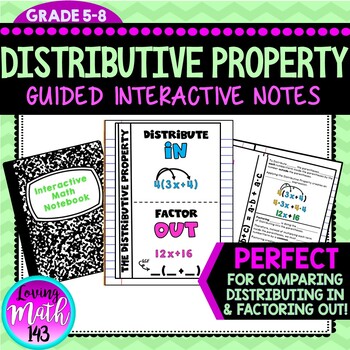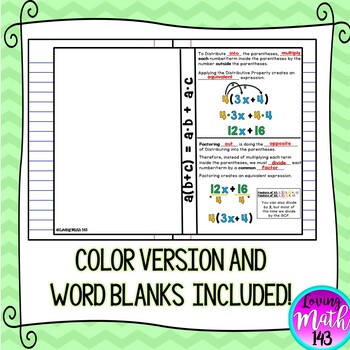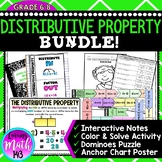The Distributive Property: Distribute IN and Factor Out Guided Notes
- PDF
What educators are saying
Also included in
- THE DISTRIBUTIVE PROPERTY: POSTER, NOTES, AND 2 ACTIVITIES BUNDLE ***********************************************************************************************1. The Distributive Property - Anchor Chart PosterThis anchor chart poster is a visual representation of the distributive property. It provPrice $7.00Original Price $9.75Save $2.75
Description
The Distributive Property: Distribute IN & Factor Out Guided Notes
This foldable is guided notes for the applying the distributive property for algebraic expressions. Students will clearly see how to distribute IN to the parentheses to create an equivalent expression and factor out the greatest common factor to create an equivalent expression.
These interactive notes include an example distributing in and factoring out. Students will see that to distribute in we must multiply and to factor out we must divide.
These guided notes will make an excellent addition to your students' interactive math notebook and/or binder! FOUR inside versions are included! This is aligned with the 6th and 7th grade common core standards.
***********************************************************************************************
HOW TO USE:
Simply photocopy back-to-back (flipping on the short side) and cut along the dotted line. Answer key is included. A choice of 4 inside versions are available.
***********************************************************************************************
WHATS INCLUDED:
★ Distributing IN to create an equivalent expression (example and steps included)
★ Factoring OUT to create an equivalent expression (example and steps included)
★ 4 Versions of inside cover.
★ Color and Black & White Version Included
OTHER ITEMS YOU MAY ALSO LIKE:
★ LCM & GCF Math interactive Notes Foldable
★ Integer Operation Rules Math Interactive Foldable
★ Mathematical Properties Interactive Foldable
***********************************************************************************************
LICENSING TERMS: This purchase includes a license for one teacher only for personal use in their classroom. Licenses are non-transferable, meaning they can not be passed from one teacher to another. No part of this resource is to be shared with colleagues or used by an entire grade level, school, or district without purchasing the proper number of licenses.
COPYRIGHT TERMS: This resource may not be uploaded to the internet in any form, including classroom/personal websites or network drives, unless the site is password protected and can only be accessed by students.






